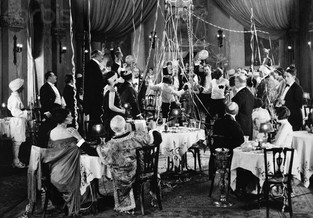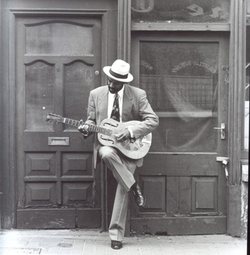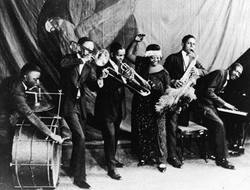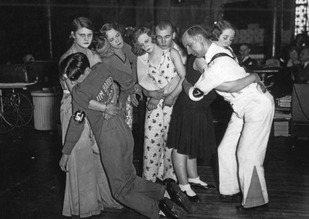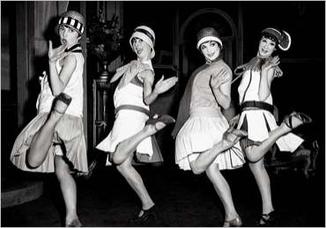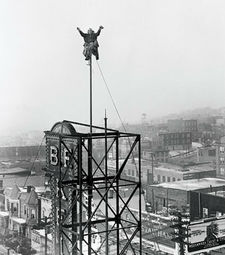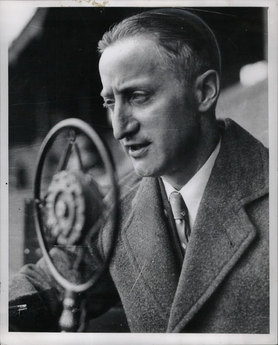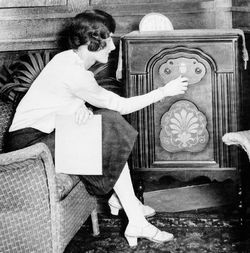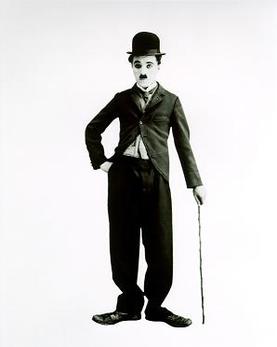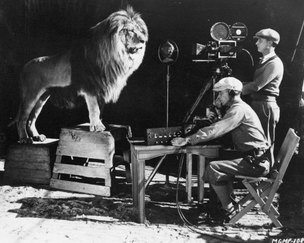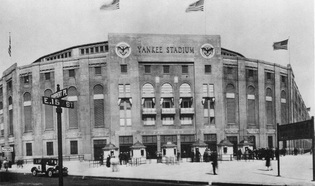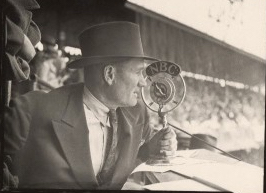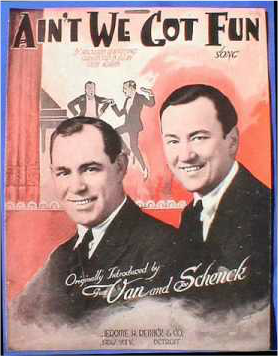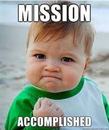POPULAR CULTURE IS BORN
FOCUS ACTIVITY
I Can Do It!
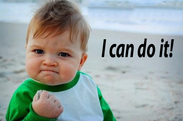
I can describe how American culture and entertainment changed in the 1920s.
TEACHING ACTIVITY
Guided Reading

DIRECTIONS: We are now going to read today's text as a class. Remember to follow along. I will select readers randomly by calling out numbers. Important terms, people, places, and events are highlighted in the toolbox.
AIN'T WE GOT FUN?
|
People of the 20s were crazy for dancing. They invented their own dances. The staid old waltzes of earlier days were just too stuffy for young people of the 20s. They kicked up their heels in a frantic caper called the Charleston. To do this dance, you had to hop, kick, touch your knees, swing your arms, and wriggle like a snake all at the same time. |
TRENDS
|
It seemed the sillier the activity, the better some people liked it. These trends, or fads, didn't usually last long. One of the fads of the 20s was flagpole sitting. A man named "Shipwreck" Kelly held the record. He sat for 49 days atop a flagpole! Other fads included games like Mah Jongg. This Chinese game was played with painted tiles. The nation also went crazy over crossword puzzles. |
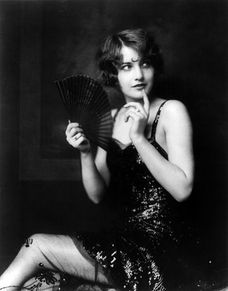 Flapper in the 1920s
Flapper in the 1920s
It was a hard time to be a parent, especially of daughters! Young women shortened their dresses, their bathing suits, and their hair. Young women went on unsupervised dates with young men. More young women took jobs. They enjoyed the money they made. They went out with their friends and started buying the latest fashions.
The word "teenager" was used for the first time in the 1920s. This was because more and more children began attending school. Parents were proud that their children were getting an education and so they kept them at home longer. Parents began using the word "teenager" when they realized that their children were not kids anymore but not yet adults.
The word "teenager" was used for the first time in the 1920s. This was because more and more children began attending school. Parents were proud that their children were getting an education and so they kept them at home longer. Parents began using the word "teenager" when they realized that their children were not kids anymore but not yet adults.
RADIO
The whole country loved radio. People listened to anything that came across the air waves. Early offerings were limited. The first shows were news and speeches. Sports quickly became a favorite. Listeners tuned in to boxing matches and baseball games.
MOVIES
A whole new set of stars burst from the screen. Al Jolson starred in The Jazz Singer. This first major "talkie" was about Jolson's life. John Barrymore starred in Dr. Jekyll and Mr. Hyde.
Sports
Radio broadcasts allowed people in rural areas to listen to sporting events that were happening in big cities. Radio broadcasters explained the games play by play to their radio audience. Some broadcaster's stories helped make many athletes into sports stars. Other stories turned athletes into villains.
Americans went to the movies and sporting events no matter who the stars were. They also danced and enjoyed jazz music. They followed silly fads. In the 20s, people were serious about having fun. A 1921 song said it all:
"Ev'ry morning, ev'ry evening, ain't we got fun? Not much money, oh, but honey, ain't we got fun?"
WHOLE GROUP ACTIVITY
Understanding Concepts
DIRECTIONS: In this activity, we will discuss the answers to the following questions:
1. What made people so determined to look for fun in the 1920s?
2. Why did people have more leisure time and money in the 1920s?
3. What is Jazz?
4. What was "The Charleston"?
5. What trends were popular in the 1920s?
6. Why were the 1920s a hard time to be a parent?
7. What things did people listen to on the radio in the 1920s?
8. Who was Charlie Chaplin?
9. How did radio broadcasters influence the careers of athletes?
10. Describe the changes in American culture before the 1920s and after the 1920s. Why do you think American
culture changed? Do you think it was a good thing or a bad thing? Why?
1. What made people so determined to look for fun in the 1920s?
2. Why did people have more leisure time and money in the 1920s?
3. What is Jazz?
4. What was "The Charleston"?
5. What trends were popular in the 1920s?
6. Why were the 1920s a hard time to be a parent?
7. What things did people listen to on the radio in the 1920s?
8. Who was Charlie Chaplin?
9. How did radio broadcasters influence the careers of athletes?
10. Describe the changes in American culture before the 1920s and after the 1920s. Why do you think American
culture changed? Do you think it was a good thing or a bad thing? Why?
SMALL GROUP ACTIVITY
Analyze This!
DIRECTIONS: In this activity, you will analyze the different types of Jazz that emerged. First, I will play a video of a jazz style. Then in your small groups, you will write a description of what you heard. Finally, we will compare and contrast the different types. If their is any time left over, or if you finish before the other groups, you may view other videos of the 1920s.
|
The Blues
Billie Holiday Good Morning Heartache Scat
Ella Fitzgerald Oh Lady Be Good Dixieland
Louis Armstrong When the Saints Go Marching In Big Band
Glenn Miller In the Mood |
Delta Blues
Robert Johnson Preachin' Blues Ragtime
Scott Joplin The Entertainer Swing
Duke Ellington It Don't Mean A Thing, If It A'int Got That Swing! Bee Bop
Charlie Parker and Dizzy Gillespie Hot House |
|
Theatrical Entertainment
Josephine Baker Dances from the 1920s
The Quick Step vs. The Charleston Dances from the 1920s
The Shimmy Crazy Fads of the 1920s
These People Weren't Afraid of Heights Silent Movies
Charlie Chaplin The Lion's Cage Silent Movies
Max Schreck Nosferatu (Dracula) - 1922 Movies
Bill "Bojangles" Robinson and Shirley Temple The Little Colonel - 1935 Baseball in the 1920s
Shoeless Joe Jackson Boxing in the 1920s
George Dixon vs. Chester Leon 1906 Sports in the 1920s
|
Dances of the 1920s
The Charleston, the Peabody and the Turkey Trot Dances from the 1920s
The Varsity Drag or Black Bottom A Dixieland Jazz Funeral
A Closer Walk With Thee Crazy Fads of the 1920s
Flagpole Sitting Silent Movies
Viola Savoy Alice in Wonderland - 1915 Silent Movies
James Rolfe Frankenstein - 1910 Movies
Vivian Leigh and Hattie McDaniel Gone With the Wind - 1940 Baseball in the 1920s
Babe Ruth's 60th Homerun! Boxing in the 1920s
Jack Dempsey vs. Jess Willard 1919 Sports in the 1920s
|
INDIVIDUAL ACTIVITY
Exit Pass
DIRECTIONS: In this activity you answer prove that you have met the Lesson Mission by answering the essential question of the lesson. Please complete the exit pass below. You will have two chances to take the pass off. The highest score will be taken for a grade. You may use the reading to help you.
HOMEWORK
Finish the Lesson and Family Time
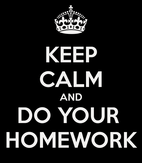
Remember, you have homework every night in Social Studies. First, share with your family what you learned in class today. Second, review your exit pass questions for each lesson and the lesson vocabulary to help you study for the test.
END OF THE UNIT 4 LESSON 7 MODULE
Making Up This Lesson
|
If you missed today and need to make up this lesson, simply read today's text and complete the Exit Pass. Paper copies will be available when you return to school. Turn in the exit pass to my tray on the kidney table after you complete it. Remember this is taken for a grade. You will have 2 days when you return to complete the assignment.
|
